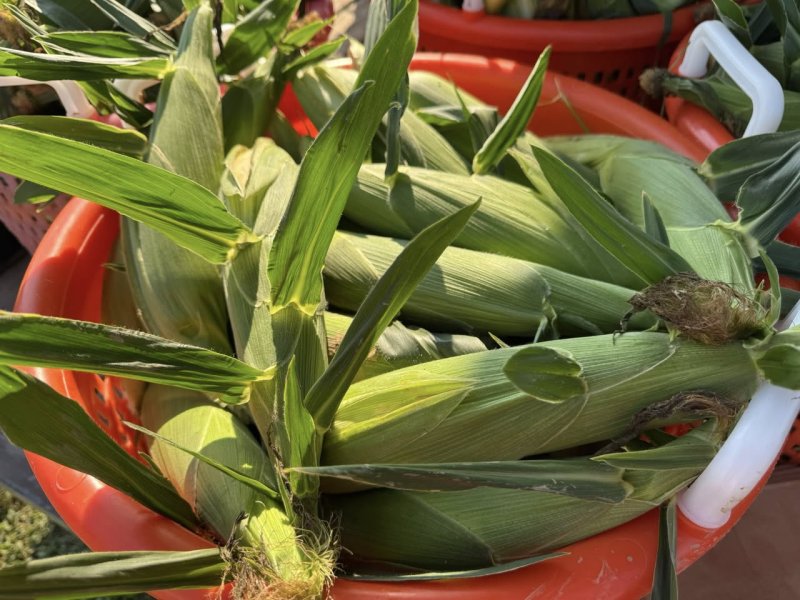Corn season offers many delightful options, but don’t delay
On a recent visit to the Historic Lewes Farmers Market, it was clear to see the season’s corn harvest was still in full swing. There were several growers offering sweet corn in yellow, bicolor and white varieties. You could tell the ears had been just picked, as their supple husks and slightly brown silks advertised their freshness. I brought home a few of the white-kerneled cobs to go into a corn bisque.
As you may know, corn is one of the truly native American crops, originating in Mexico almost 7,000 years ago. Recipes that featured corn did not appear in published cookbooks until the early 1700s, when European settlers became familiar with various ways to use the novel (to them) food. In some countries, corn is still not considered a human food, but suitable only for livestock.
Botanically, corn is classified as a grass, known as Zea mays, which is where it earned the name maize. Corn as it was originally cultivated is quite different from the tender, sweet kernels we enjoy eating today. One of the oldest types is called flour corn, grown by Native Americans and also called soft or squaw corn. Several different varieties of flour corns are ground into yellow or white cornmeal.
The colorful corn seen in fall decorations is known as flint corn. These small, multicolored kernels with a tough outer shell are edible, either dried and ground or toasted in a skillet, although you’ll find their taste not at all sweet. A familiar type of flint corn is what we know as popcorn. The kernels have a soft, starchy center inside a very hard shell. As you heat the kernels, their internal moisture becomes steam, exploding the shell, leaving behind a white, fluffy mass that’s delicious when salted and drowned in melted butter.
The term “field corn,” as opposed to “table corn,” usually refers to dent corn, the most widely grown variety, found in everything from cornflakes to ethanol. Almost all the field corn grown in Delaware goes to the poultry industry as feed corn. Softer than Indian corn but harder than flour corn, its kernels have a thick case around a starchy center. The name comes from their appearance: As the inside dries and shrinks, the kernel’s outside develops a noticeable dent.
The corn we look forward to eating off the cob every summer is sweet corn. The term includes the popular sugar-enhanced varieties like Supersweet or Silver Queen that contain up to 10% sugar. Although these varieties have been bred to retain their flavor and moisture longer after harvest, purists will insist sweet corn should be eaten the same day it’s picked. Sweet corn will convert almost half its sugar to starch within 24 hours.
Now that you have a few ears of corn at the ready, here are a couple of soup recipes to consider. The corn and crab chowder is zesty compared to the tomato corn chowder, a simple bisque that relies on a reduction of the water in which the cobs have been simmered. You can either boil the ears (keep the water) or cook them in the microwave before removing the kernels. Of course, the best way to eat corn is right off the cob — grilled, steamed or roasted — dressed simply in butter, salt and pepper. One bite and you’ll know why they call it sweet.
Corn and Crab Chowder
Render bacon in a Dutch oven or soup pot over medium-high heat. Remove bacon (reserve for a BLT or a breakfast omelet) and keep the fat to sauté the celery, peppers, onion and potato for about 5 to 10 minutes. Sprinkle in flour and stir until it dissolves. Add broth and simmer for 15 minutes, stirring often to incorporate any browned bits from the bottom of the pan. Add corn and cook for 5 minutes. Stir in crab, cream, salt and pepper; cook just below a boil until warmed through. To serve, garnish with snipped chives. Yield: 6 servings.
Corn and Tomato Chowder
Scrape corn kernels from cobs into a bowl; set aside. Place cobs in a large pot and cover with water; simmer for about 1 hour. Scrape cobs with the flat blade of a knife to remove any remaining kernels. Discard cobs and reduce liquid by at least half. Add reserved kernels to the pot. Stir grated onion into the pot; simmer until softened, about 10 minutes. Peel, seed and chop tomatoes; add to the pot. Stir in butter and milk. Simmer until heated through. Season to taste with salt and pepper. Yield: 4 servings.





















































